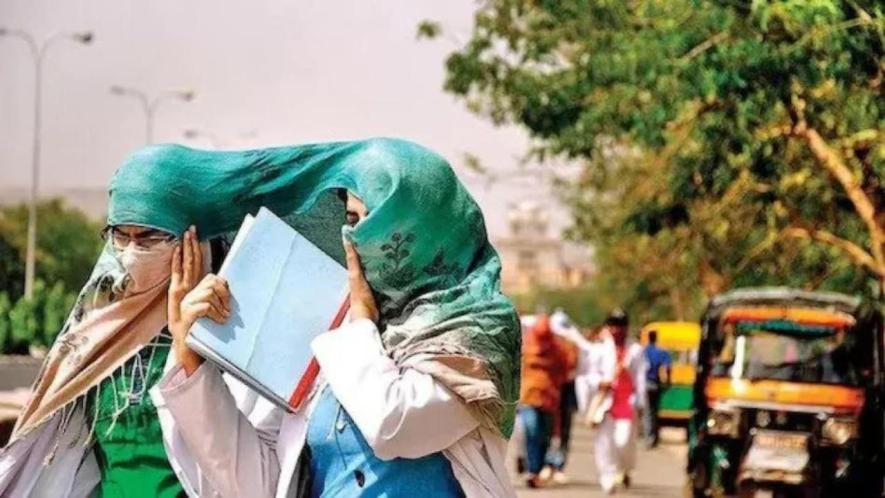Extreme Heat is Here to Stay

Image Courtesy: PTI
The year 2023 has officially been declared the hottest year ever since global temperature records were kept in 1850, breaking the previous highest set in 2016. This was not a flash in the pan. Ten of the hottest years ever have been in the decade 2014-23. Average global temperature in 2023 was 1.18 deg C (degrees Celsius) higher than the 20th Century average, and about 1.4 deg C higher than the late 19th century average, almost touching the dreaded 1.5 deg C limit set by the Paris Agreement and beyond which several changes in climate may become irreversible. The record-breaking heat of last year is expected to continue well into 2024 as is being witnessed right now.
Severe and prolonged extreme heat conditions often accompanied by droughts and wildfires have been experienced from March to May, and now June, in many different parts of the world such as West Africa, the Sahel, southern Africa, southern, western and north-eastern US, and southern Europe especially Greece and Italy. West Asia, notably Saudi Arabia, has been hard hit by temperatures exceeding 50C, with over 500 pilgrims reportedly having lost their lives in Makkah during the annual Haj. Pakistan too has seen temperatures of over 50C on several days.
India has been among the worst hit. North and North-West India have suffered severe and prolonged heat waves unbroken over a record three weeks, with some parts experiencing temperatures over 50C. While health records are notoriously poor, as evidenced during the Covid pandemic, health ministry officials have reportedly confirmed over 40,000 cases of suspected heat stroke and about 110 deaths since the beginning of March 2024. One can only guess at the possibly many-fold numbers of heat-related illness and mortality that would have occurred outside of hospitals and clinics.
Repetitive occurrence of extreme heat over the past several years, this year being perhaps the worst, shows beyond doubt that the climate crisis has well and truly set in. Scientists expect things to get worse in the near term as regards both global temperatures and extreme weather. Further, due to the momentum built-up by historic and continuing high greenhouse gas emissions, heat waves and associated extreme events are expected to continue occurring over the next couple of decades even if current emissions are brought under control to requisite levels.
Besides international efforts to curb emissions causing climate change, India and other countries must now take decisive actions to check widespread heat-related morbidity and mortality, loss of productivity and health impacts especially on vulnerable sections of the population.
El Nino
The extreme heat is exacerbated by what is known as the El Nino (pronounced neenyo, El Nino being the name given to the infant Jesus in Spanish or, more generically, the infant boy) Southern Oscillation, which is a coupled oceanic temperature-atmospheric pressure phenomenon driving global climate and alternating between an, or El Nino warm-phase and an El Nina (pronounced neenya or infant girl) cool phase.
It should be noted that the SO phenomenon is not a cause for high global temperatures or the current heat waves but an added factor to take into account. For instance, the past 10 years have been the hottest ever, but these ten years have been a mixed bag of warm, neutral and cool phases of the Southern Oscillation.
The persistence of El Nino conditions till the middle of this year has also contributed to a relatively weak monsoon in peninsular India so far, with roughly 20% less rainfall in June compared with the long-term average. The reduced rainfall and weak monsoons thus far has exacerbated extreme heat conditions and threatens summer sowing and the kharif crop. Climate scientists predict that the current El Nino warm phase, which has been on-going for the past two years, will transition to a neutral phase by June this year and may thereafter shift to a cool phase later, usually associated with lower temperatures and higher rainfall.
Understanding Extreme Heat
India has a rather rigid and unhelpful definition of heat waves, occurrence of which is then supposed to trigger governmental response.
A heat wave is officially declared when maximum temperatures cross 40C and is 4.5-6.4C higher than normal, or when maximum temperatures cross 45C, these conditions persisting for at least 2 days. The 40C threshold is lowered to 37C for coastal areas with 4.5C departure from normal and 30C for hill areas.
Such a definition is unsatisfactory for several reasons. Extreme heat is not only a meteorological phenomenon but is felt by humans (and animals, birds etc) locally relative to their usual experience. With all the difficulties involved, more localized definitions would be better.
Even at a macro-level, the official definition does not account for humidity which amplifies the effects of high temperature on the human body. Dry heat prompts dehydration. However, the higher the humidity, the lower is the ability of the body to cope with the elevated temperature by evaporation of sweat and the resultant cooling effect. Inability of the body to cool itself raises body temperature, and imposes strain on the cardio-vascular system and on vital organs, and may even cause death.
This year humidity has been significantly higher in India due to a combination of climatic and atmospheric conditions. Conditions over the Arabian Sea during early summer brought more moisture-laden air over peninsular India easing temperatures but raising humidity. Cyclonic conditions over the Bay of Bengal brought extra humidity over West Bengal and Odisha resulting in a debilitating heat wave. North and north-west India saw westerly disturbances from the Mediterranean adding humidity to the extreme heat over this region.
Many countries, therefore, use a Heat Index which combines temperature and humidity to a single “equivalent” number. A Heat Index chart shows what particular temperatures “feel like” at different humidity. For instance, in March April this year, coastal Chennai with higher humidity had higher heat index or “felt hotter” than Delhi even though the latter had consistently higher temperatures. Heat Index may, therefore, provide a better, more localized trigger for official response than a rigidly defined temperature parameter.
As predicted by climate scientists, minimum temperatures have also been much higher than normal during the current heat waves, especially in urban areas, a special case discussed further below. For instance, minimum temperatures have been above 30C in many parts of north India when maximum temperatures have been in the low to mid-40s. Higher minimum temperatures do not allow the body to recover from the high day time temperatures and impose additional stress on the body.
Urban Heat Islands (UHI)
Urban areas pose special and additional problems, but also offer opportunities for preventive action.
Cities and towns mostly experience 2-4C higher temperatures than surrounding rural areas. This is due to a phenomenon called the Urban Heat Island (UHI) effect. UHI is caused by concrete infrastructure and buildings, tarmac roads, and other surfaces which absorb heat during the day and radiate back into the ambient surroundings. Tall buildings and congested areas block movement of air and trap heat as well as air pollutant is in a sort of bubble around urban areas. The higher minimum temperatures witnessed is largely due to UHI.
The problem is worsened by unplanned urban development and severe depletion of green cover that could have contributed to lowering temperatures through evapo-transpiration, the process which plants release moisture and thus contribute to a cooler environment, simultaneously absorbing carbon dioxide emissions. Depletion of water bodies too has a similar effect. Ensuring around 20% green cover, well distributed so as to provide micro-climate benefits to low-income settlements, could reduce urban temperatures by 2-2.5C in urban areas.
Another major contributor to UHI is waste heat i.e. heat released into the urban environment especially by air-conditioners, automobiles and other machinery. About 50% of electricity in cities is used by ACs alone. It is estimated that city temperatures can be reduced by 1.5-2C just by ensuring that all ACs are energy-efficient and operate at temperatures of 26C or more by mandating such restrictions in offices and commercial establishments. If energy-efficient buildings are also ensured, in conjunction with increased green cover, the UHI could almost totally be neutralized.
Limitations of space do not permit further elaboration here.
Vulnerabilities
It would be readily understood that the elderly, infants and children, pregnant women, and those with pre-existing morbidities especially cardiovascular ailments would be highly susceptible to heat-related ailments. Public health systems may, or at least should be, able to respond to this section of people, who may also be advised to stay indoors and avoid physical exertion as much as possible, hydrate properly and take other precautions. School children are usually assisted by closing schools during severe heat waves.
All outdoor workers, especially construction workers and those engaged in hard manual labour, street vendors, gig services and delivery workers, unorganized sector workers especially in aptly-named “sweat shops,” maids and domestic help etc are exposed to extreme heat under the open sun and while engaging in strenuous work. The homeless, indigent and disabled too are exposed to harsh conditions with little by way of relief. These sections need protection and special attention from extreme heat.
Efforts so far have been extreme feeble and disorganised.
Heat Action Plans (HAP)
In order to respond to heat waves, national guidelines have been drawn up by the National Disaster Management Authority (NDMA). Based on these, each State, urban local body and municipality are expected to draw up Heat Action Plans, the first of which was promulgated in Ahmedabad. It is understood that the Guidelines are being reviewed and, hopefully, HAPs would be thoroughly revamped as well.
The Guidelines and hence most HAPs bear the stamp of the NDMA which approaches issues on a post-facto basis as responding to a natural disaster over which one has no control, which has already happened, and which calls for an emergency reaction. At present, the HAPs vary widely from state to state in terms of both what they cover and as regards institutional arrangements. As a result, most of the responses which are triggered by the very formalized and constructed definition of heat waves discussed above are reactive with little or no emphasis on preparation and precautions, let alone longer-term measures.
As a result, recommended measures are a mixed bag of numerous suggestions, and suggested institutional arrangements leave the recommendations toothless.
For instance, several HAPs recommend that construction workers work staggered hours avoiding peak heat hours of 12-4pm during which they are provided shelters with drinking water and cooling arrangements. However, not making these mandatory, or placing responsibility on specific officials or agencies, renders these guidelines ineffective.
In conclusion it is strongly suggested that trade unions, mass organisations, those working with unorganised workers, peoples science movements and other civil society organisations work in a concerted fashion to provide relief and guidance to people especially vulnerable sections, put pressure on authorities to reform and strengthen health systems and Heat Action Plans. Extreme heat is here to stay. Efforts to contain its effects, and lower temperatures where possible such as in urban areas, are essential.
D. Ragunandan is with the Delhi Science Forum and the All India People’s Science Network. The views are personal.
Get the latest reports & analysis with people's perspective on Protests, movements & deep analytical videos, discussions of the current affairs in your Telegram app. Subscribe to NewsClick's Telegram channel & get Real-Time updates on stories, as they get published on our website.























